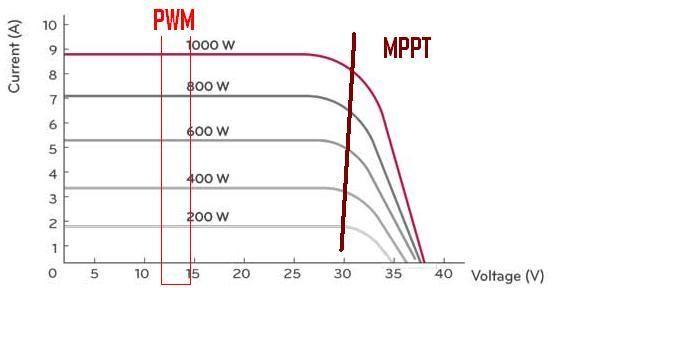Calkidd
Apr 22, 2016Explorer
Voltage vs. PWM controller & wire size
Ok, there is a recent thread out there MPPT vs. PWM and some post were a little confusing to me. Instead of hijacking his thread I started a new one.
My set up is two 208 watt Sony panels with 28.71 volts (I.E. 24 volt panel) which is 14.5 amps. (V * A = Watts).
What I don't understand is the difference in amp production between the MPPT and PWM. In the other thread there was some math that did not add up or followed Ohm's law formula. Someone mentioned with the higher voltage it was better to go with a MPPT controller rather than a PWM. But why? I know some will say the MPPT handles the extra voltage and turns it to amperage. HUH?
Regardless of what voltage is going into the controller it will come out at 14.4 - 14.8 volts. Right? Thus ohm's law says my system amperage, on a perfect day, would produce 28 amps out from the controller, no?
I understand using such a higher voltage panel for 12 volt charging system is an overkill, but these panels are left over from a previous residential install I own. As long as the controller can handle the voltage a PWM should work fine. For example I am using the Bogart 2030 controller with the Trimetric monitor.
On a side note another rant.
I read Handy Bob's information and other research about wire size. Ok, I get that, but if 10 ga works why in the hell are people using 8 or even 6 ga to run their solar panels when the loss is 2-5% with 10 ga? After doing the voltage drop calculations with my system with a run of 30 feet (being very liberal here) I only have a 3% loss of voltage.
Also, why are some using 1/0 ga for inverter and battery wiring? HOLY ****! We are talking about a cable that can handle 150 amps. Tell me what 12 volt load could anyone be possibly using in an RV that produces that much amperage? Wouldn't 2 ga be just fine?
My set up is two 208 watt Sony panels with 28.71 volts (I.E. 24 volt panel) which is 14.5 amps. (V * A = Watts).
What I don't understand is the difference in amp production between the MPPT and PWM. In the other thread there was some math that did not add up or followed Ohm's law formula. Someone mentioned with the higher voltage it was better to go with a MPPT controller rather than a PWM. But why? I know some will say the MPPT handles the extra voltage and turns it to amperage. HUH?
Regardless of what voltage is going into the controller it will come out at 14.4 - 14.8 volts. Right? Thus ohm's law says my system amperage, on a perfect day, would produce 28 amps out from the controller, no?
I understand using such a higher voltage panel for 12 volt charging system is an overkill, but these panels are left over from a previous residential install I own. As long as the controller can handle the voltage a PWM should work fine. For example I am using the Bogart 2030 controller with the Trimetric monitor.
On a side note another rant.
I read Handy Bob's information and other research about wire size. Ok, I get that, but if 10 ga works why in the hell are people using 8 or even 6 ga to run their solar panels when the loss is 2-5% with 10 ga? After doing the voltage drop calculations with my system with a run of 30 feet (being very liberal here) I only have a 3% loss of voltage.
Also, why are some using 1/0 ga for inverter and battery wiring? HOLY ****! We are talking about a cable that can handle 150 amps. Tell me what 12 volt load could anyone be possibly using in an RV that produces that much amperage? Wouldn't 2 ga be just fine?
